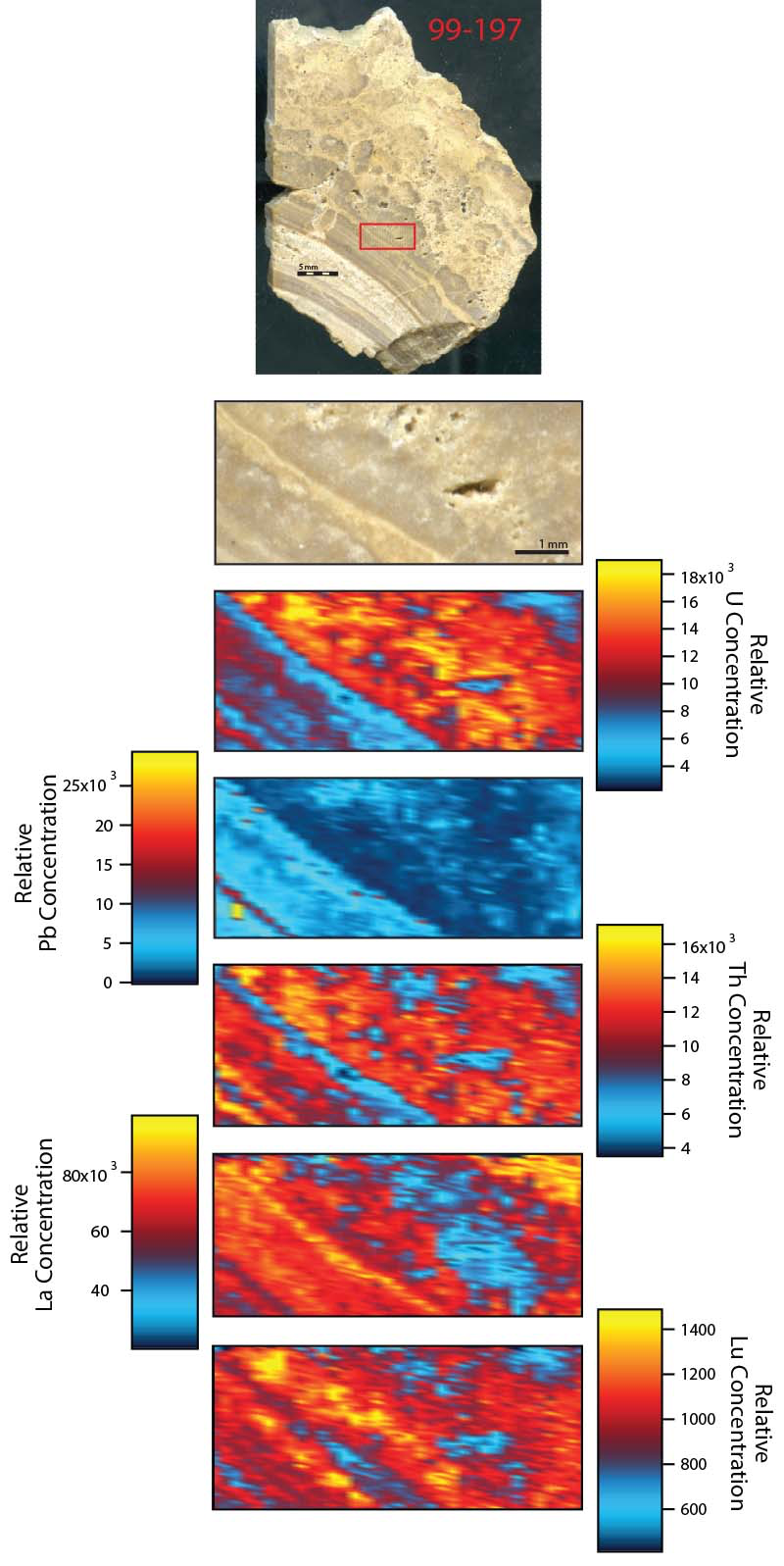Reports: ND854923-ND8: Uranium-Lead Dating and Correlation of Lacustrine Carbonates of the Green River Formation: Context for Paleo-Environmental Architecture of Lake Types
Sidney Hemming, PhD, Columbia University
Figure 1. Map of occurrence of the Green River Formation (modified from Seard et al., 2013)
This project involved a combination of field work and petrographic, stratigraphic and analytical efforts to test the potential for U-Pb dating of carbonates in the Eocene Green River Formation. A review of this method can be found in Rasbury and Cole (2009). The resources went largely to supporting a graduate student, Guleed Ali, who’s Ph.D. thesis was on the Mono Basin lake level fluctuations (Ali, 2018), and secondarily to the field and analytical work. During Ali’s field work in the Mono Basin, we became skilled at selecting samples that have high U/Th and therefore allow highly precise ages to be obtained. We reasoned that the same sampling strategy could lead to high quality U-Pb dating of carbonates from older deposits, such as the Green River Formation. We spent a field season in the area around La Barge, WY (Fig. 1). At this site previous workers had identified and described the presence of large insect mounds (reefs), including some evidence of spring activity (e.g., Siviero, 2012; Seard et al., 2013, and references therein). Our examination, in the context of understanding developed in our studies of the stratigraphy and associated carbonates in the Mono Basin of California, led us to conclude that all of these insect mounds have substantial spring activity associated with them. Additionally, we found several volcanic layers. The previous workers had only documented one volcanic layer and assumed that the volcanic layers they found at various outcrops were the same one (e.g., Siviero, 2012). As we found multiple volcanic layers at each outcrop, the degree of correlation of the carbonate buildups will require more careful assessment of the correlation of the volcanic layers. We started on one layer with this funding. We are planning to expand our study of both the volcanic layers and the carbonates if we can find further resources to continue the work. The discovery of multiple volcanic layers is very exciting because of the potential for extremely high-precision dating (e.g., Machlus et al., 2015).
The analytical work accomplished for this project is laser ablation ICP-MS screening of polished slabs of carbonate, following petrographic examination. In addition to the U, Th and Pb measurements for the chronology screening, this method yields a variety of elemental data that can be further used for developing our understanding of the best sampling strategy for dating lacustrine carbonates such as these. Based on the screening of approximately 30 samples from the potential areas highlighted in Fig. 1, two appear to have promising systematics for U-Pb dating, and more thorough ICP-MS screening has been performed on these, in preparation for sampling for ID-TIMS analyses.
A sample from the La Barge area (Fig. 1) that we collected based on our understanding developed for U-Th in the Mono Basin, STR-01 (Fig. 2, 3, 4), was studied in detail following initial screening that suggested it had promise for dating. The layer is above the Layered or 5th tuff that has been previously dated at 49.919+/-0.040 Ma by Machlus et al. (2015). The laser ICP-MS result is 53.2+/-5.4 Ma, and the range of 238U/206Pb is 8-80, indicating that it is likely to provide a 1% result with ID-TIMS.
Figure 2. Sampling site for STR-01. This travertine sample comes from N42°24’16”, W110°15’11.3”.
Figure 3. Photograph of polished section of STR-01, as well as concentration map of U and locations of spot analyses used for the screening.
Figure 3. Laser ICP-MS results for STR-01.
We additionally studied a previously collected sample, 197, the lower part of the Wilkins Peak member in Firehole Canyon on the west side of the Rock Springs uplift (Fig. 1, 5, 6), and is located 20 meters above the 2nd Tuff that has been previously dated at 51.279+/-0.020 Ma by Machlus et al. (2015). The result we obtained is 49.6+/-6.8 Ma, and the range of 238U/206Pb is ~0 to 60, so we expect to get a ca. 1-2% result with ID-TIMS.
Figure 5. Photographs and element images of sample 197.
Figure 6. Laser ICP-MS result for sample 99-197.
REFERENCES CITED
Ali, G. A. H., 2018, Late Glacial and Deglacial Fluctuations of Mono Lake, California, Disertation, Columbia University in the city of New York.
Bohacs, K. M., A. R. Carroll, J. E. Neal, P. J. Mankiewicz, 2000, Lake-basin type, source potential, and hydrocarbon character: an integrated-sequence-stratigraphic– geochemical framework, in E. H. GierlowskiKordesch and K. R. Kelts, eds., Lake basins through space and time: AAPG Studies in Geology 46, p. 3–34.
Bradley, W. H., 1929a, The varves and climate of the Green River epoch: U.S. Geological Survey Professional Paper 158-E, p. 87-110.
Machlus, M. L., Ramezani, J., Bowring, S. A., Hemming, S. R., Tsukui, K., and Clyde, W. C., 2015, A strategy for cross-calibrating U–Pb chronology and astrochronology of sedimentary sequences: An example from the Green River Formation, Wyoming, USA, Earth and Planetary Science Letters, 413, 70-78. Rasbury, E. T., and Cole J. M., Directly dating geologic events: U‐Pb dating of carbonates, Reviews of Geophysics, 47, 1-27. Seard, C., Camoin, G., Rouchy, J.-M., and Virgone, A., 2013, Composition, structure and evolution of a lacustrine carbonate margin dominated by microbialites: Case study from the Green River formation (Eocene; Wyoming, USA), Palaeograpraphy, Palaeoclimatology, Palaeoecology 381-381, 128-144.
Siviero, B. C. T., 2012, Paragenesis of Lacustrine Microbialites in the upper Wilkins Peak Member, Green River Formation, Wyoming, Ph.D. dissertation, Loma Linda University.

















